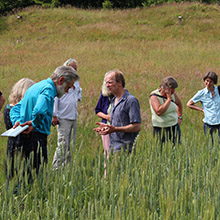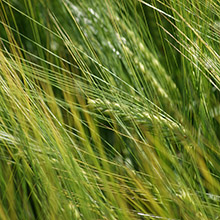SaaGodt
Saagodt
- Organic Seed - a healthy yield from the outset
Seed can get infected with fungal diseases. Especially for organic farmers it is very important to have access to the healthiest and most fast-growing seed to avoid diseases in the crops and poor resistance against weed.
There are limited options when it comes to treating diseases in organic seed, and there is a lack of knowledge on the conditions that influence the germination rate of the grain.
The SaaGodt project has exanimated the quality of organic certified seed and tested technical methods that treat seed-borne diseases to learn how the different treatment methods affect the germination rate. The project focused on developing technical equipment, where a combination of high-pressure steam and ultrasound (SonoSteam) is being used to control common bunt.
Also, the project compared seeds that are bred in different manners with different row spacing and fertilizer levels. Furthermore, the differences between organic and conventional crops are compared to detect how the germination rate in organic seed potentially can be improved.
Project period: 2017-2020
Results and recommendations
New equipment to control common bunt
The toolbox to control common bunt has been increased as a part of the SaaGodt project. The new equipment combines high pressure steam and ultrasound (SonoSteam) and can treat seed-born diseases in several types of crops very effectively. This method concentrates the heat on the surface of the seed where the spores are, and the precise treatment can be stopped before the heat penetrates vital parts of the seed.
Vinegar is a well-functioning seed treatment to control common bunt
Vinegar seed treatment can control common bunt, because acid from the vinegar removes the fungus common bunt. The crucial factor that determines the antifungal effect of the treatment is for how long the vinegar is in contact with the seed.
It is possible to treat common bunt with saponin and laminarin
The SaaGodt project has confirmed the effect of existing commercial treatment methods such as Tillecur, ThermoSeed and E-Vita. Furthermore, the project succeeded treating common bunt with the use of saponins and laminarin.
Certified organic seed is of high quality
By comparing the yield from respectively organic and conventional seed the SaaGodt project examined the quality of certified organic seed in Denmark and has concluded that the quality is high. The conclusion is based on a series of yield experiments. The experiments have shown that under normal circumstances there is no difference in the yield from certified organic seed and the yield from conventional seed. Therefore, it cannot be concluded that organic seed is of lower quality or that the yield is lower when comparing with conventional seed.
The significance of the results – Implementation in practice
The different treatment methods against common bunt are each appropriate in different situations. The quantity of infected seed that needs treatment is the key factor because the different treatment options have different costs.
Industrial treatment methods such as ThermoSeed and E-Vita are the most appropriate options when it comes to larger commercial treatment of certified seed. We still have limited knowledge about SonoSteam because it is a new method but results from the SaaGodt project indicates that SonoSteam is a competitive method regarding establishment costs and operational costs, when comparing with existing industrial treatment methods.
Currently vinegar seed treatment is most appropriate for treatment of smaller quantities. However, the results from the SaaGodt project also suggests that the vinegar method can be further developed and become a functioning industrial treatment method controlling common bunt at a larger scale.
The raw material price of laminarin and saponins must be lower before treatment methods with these substances can compete with well-established treatment methods. New biogas plants are under construction and are expected to lower the raw material price of both laminarin and saponins.
The project has also obtained knowledge about the germination rate of grain. When seed is bred under extremely low input growing conditions the yield appears to be lower. However, this must be considered with certain reservations because there are several other circumstances that affects the yield under extremely low input growing conditions. With the reservations mentioned the project concludes that seed should be bred under good growing conditions since extremely low input growing conditions means lower yield.
Articles
Articles from book of abstract from the conference Eucarpia Liceseed, March 2021:
- SEED TREATMENTS TO CONTROL COMMON BUNT
- YIELD POTENTIAL IN ORGANIC AND CONVENTIONAL CEREAL SEED
- VINEGAR SEED TREATMENT TO CONTROL COMMON BUNT IN WHEAT
Project partners
- Agrologica
Houvej 55
9550 Mariager
Att: Anders Borgen - Nordic Seed A/S
Grindsnabevej 25
8300 Odder
Att: Hans Haldrup - FORCE Technology
Park Allé 345
2605 Brøndby
Att: Niels Krebs
Project leader
Anders Borgen
Agrologica
Houvej 55
DK-9550 Mariager
Email: borgen@agrologica.dk
Phone.: + 45 55 81 35 18


